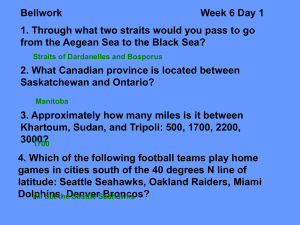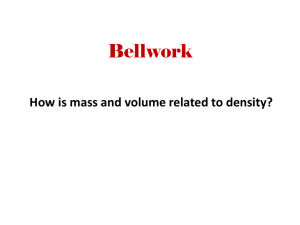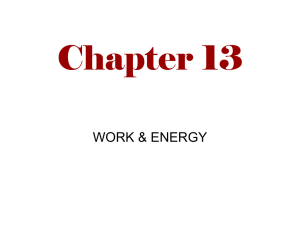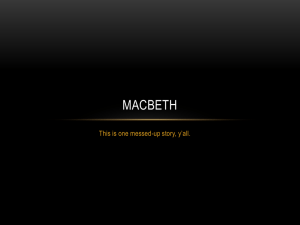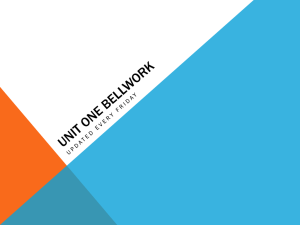CM 4 Bellwork - Fordson High School
advertisement
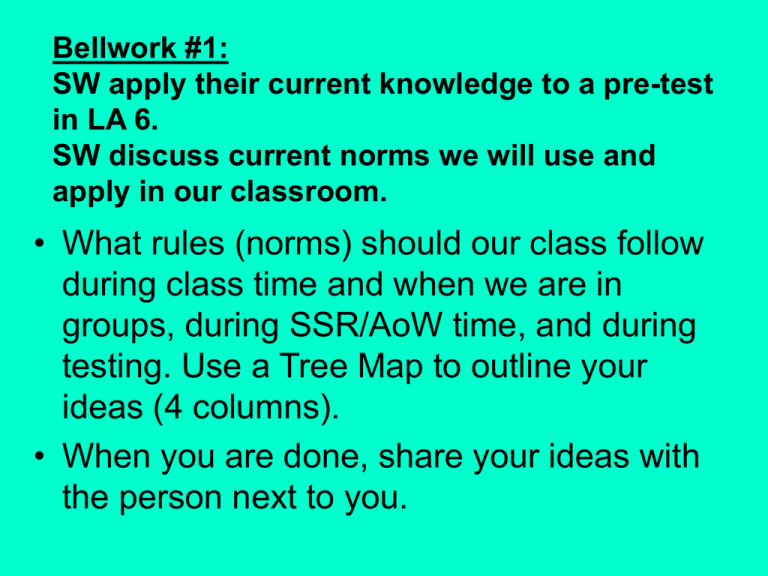
Bellwork #1: SW apply their current knowledge to a pre-test in LA 6. SW discuss current norms we will use and apply in our classroom. • What rules (norms) should our class follow during class time and when we are in groups, during SSR/AoW time, and during testing. Use a Tree Map to outline your ideas (4 columns). • When you are done, share your ideas with the person next to you. Bellwork #2: SW respond to a writing impromptu essay during class time. SW discuss the syllabus, rules, and expectations for this semester. • What are your goals for school this semester? What do you want to accomplish by the end of the school year? • Create a circle map of your goals. Bellwork #3: SW discuss the syllabus, expectations, and rules for the class. SW discuss, annotate (T2T), and interpret the AoW and apply SOAPSTone to it. • Explain in detail our test retake and formal paper revision policy. Bellwork #4: SW discuss criteria for writing a good essay for the ACT writing section. SW create scenarios for an ACT writing prompt. Underline the pronoun in each sentence and then circle its antecedent. 1. Leila, are you going to the party tonight? 2. When Paul drove up, everyone piled into his car. 3. Moe said that he would be absent today. 4. During the storm, the house lost its antennae. 5. “I must not forget,” the child said over and over again. Bellwork #5: SW discuss criteria for writing a good essay for the ACT writing section. SW create anecdotes for an ACT writing prompt. Fill in each blank with a pronoun, then circle the antecedent. 1. Emily Dickinson spent much of _______ life in Amherst. 2. Tarek, would ______ please give us a hand. 3. All of her friends sent her ________ best wishes. 4. With _______ motor running, the car sounded like a washing machine. 5. Tom Sawyer didn’t always do ______ own work. Bellwork #6: SW discuss criteria for writing a good essay for the ACT writing section. SW create a counterargument/rebuttal for an ACT writing prompt. • Comma Rules: 1. Use commas to separate independent clauses (complete sentences) that are joined using one of the seven coordinating conjunctions (FANBOYS). 2. Use commas after dependent clauses, introductory phrases, or introductory words that precede the main clause. Apply these rules to the following sentences: 1. The receptionist suffered from a sore throat but he stayed at work. 2. The dog obviously wanted to play fetch yet the owner didn’t recognize this. 3. My car was stolen so I filed an insurance claim. 4. Because I ate too much food I could barely move. 5. Yes he punched me. Bellwork #7: SW discuss and decide how and what order to put the body paragraphs together. SW create their final draft of their essay. • Comma Rules: 3. Use commas to bracket clauses, phrases, and words that provide non-essential information. 4. Use commas to separate three or more words, phrases, or clauses written in a series. Apply these rules to the following sentences: 1. My uncle who runs marathons writes advertisements for cereal jingles. 2. The movie in my opinion lacked any redeeming qualities. 3. Sarah went to the store and bought milk eggs and cheese. 4. The girls across the street like to jump rope ride bikes and swim. 5. He jumped the fence sprinted through the back yard and then he jumped into the pool. Bellwork #8: SW critically read and T2T a LA times article debating a brain-dead Texas woman on life support. SW frame their argument for or against the issue using the pre-writing, Framing an argument. • Comma Rules: 5. Use commas to separate two or more coordinate adjectives that describe the same noun. 6. Use commas at the end of a sentence to indicate a distinct pause or shift. Apply these comma rules to the sentences below: 1. Mary is a shy introverted child. 2. My aunt bought an energetic nervous dog. 3. He was content not overjoyed. 4. The dog looked thoughtful almost human. 5. You’re a fisherman aren’t you? Bellwork #9: SW critically read and T2T a LA times article debating a brain-dead Texas woman on life support. SW frame their argument for or against the issue using the pre-writing, Framing an argument. Comma Rule: 7. Use commas to set off a phrase at the end of a sentence that refers back to the beginning or middle of a sentence. 8. Use commas to set off all geographical names, items in a date (except the month and date), address (except the street number and name), and titles in names. Apply the following rules to the following sentences: 1. The crazed motorist sped away cackling maniacally. 2. The lobster scuttled away from the waiter brandishing its claws. 3. Sacramento California is the state capitol. 4. November 4 2013 was election day. 5. The election will determine who lives at 1600 Pennsylvania Avenue Washington DC. Bellwork #10: SW discuss three ways to set up and argument and formulate their point of view. SW create two separate groups and then argue their points and evidence with each other. Comma Rule: 9. Use commas to shift between the main discourse and a quotation. Use any of the rules we have discussed so far to correct the following sentences, then tell me which rule you use: 1. Chuck ate the last piece of pizza then asked “Was that mine or yours?” 2. Because Mitch fell off his bike he twisted his ankle badly. 3. The cat was seeking affection but she couldn’t catch her owner’s attention. 4. In the kitchen Louisa was burning their dinner. 5. Seattle Washington is a rainy city. Bellwork #11: SW use all the evidence and points they have made I heir debate and using their template and construct an argumentative essay. SW use the paragraph template to begin their essay. Using the comma rules you have learned, apply them to the following sentences and write which rule you used to correct each sentence. 1. Well I could have sworn that I saw him but I could be wrong. 2. Doug is a mean spiteful man. 3. My new car according to my father is fancy expensive and impractical. 4. After tucking me in at night my mom always said “Sleep tight. Don’t let the bedbugs bite.” 5. The salesman was aggressive practically threatening. Bellwork #12: SW read, dissect, and interpret a writing prompt and then split up sections and report out. • Some high schools in United States have installed security cameras in various locations throughout the school, including the classrooms. Some educators and parents think that student behavior must be constantly monitored in order to ensure the safety of both teachers and students. Others think that security cameras can create distractions during class and even promote bad behavior in some students. • Create a scenario for this writing prompt. Bellwork #13: SW create an anecdote for the following writing prompt. SW practice all parts of the writing prompt for the ACT. • Some high schools in United States have installed security cameras in various locations throughout the school, including the classrooms. Some educators and parents think that student behavior must be constantly monitored in order to ensure the safety of both teachers and students. Others think that security cameras can create distractions during class and even promote bad behavior in some students. • Create an anecdote for the above writing prompt. Bellwork #14: SW attend an ACT orientation in the auditorium. • Which is easier for you to write, a scenario, an anecdote, or a counter argument/rebuttal? Why? Bellwork #15: SW read for 15 minutes (SSR) and respond to sentence stems. SW read an AoW and respond with a 4 square. • Take 15 minutes to read a novel you chose for SSR. • On a separate piece of paper summarize what you have read and use one of the following sentence stems: • While I was reading I felt….. • I was surprised by….. • Because of _____ I assumed….I • I wonder if ….. Bellwork #16: SW read for 15 minutes (SSR) and respond to sentence stems. SW respond to a metacognitive log concerning their SSR novel. • Take 15 minutes to read a novel you chose for SSR. • On a separate piece of paper summarize what you have read and use one of the following sentence stems: • While I was reading I felt….. • I was surprised by….. • Because of _____ I assumed….I • I wonder if ….. Bellwork # 17: SW read for 15 minutes (SSR) and respond to sentence stems. SW read an AoW and respond with a 4 square. • Take 15 minutes to read a novel you chose for SSR. • On a separate piece of paper summarize what you have read and use one of the following sentence stems: • While I was reading I felt….. • I was surprised by….. • Because of _____ I assumed….I • I wonder if ….. Bellwork #18: SW read for 15 minutes (SSR) and respond to sentence stems. SW read an AoW and respond with a 4 square. Bellwork #19: SW discuss and T2T with an article on The American Dream. SW work in groups with Expert Folders concerning OMAM. • Create a bubble map with the American Dream at the center. Use adjectives to describe the American Dream. Come up with 5-10. Bellwork #20: SW work in groups with Expert Folders concerning OMAM. SW T2T on one specific article from their expert folders and create a thinking map based upon it, then share out with their group. • What new learnings did you find out from your expert folders so far? Bellwork #21: SW conduct a Gallery Walk based up their circle maps on OMAM. SW discuss their findings and take some background notes on OMAM. • Write Gallery notes for BW, then write your notes from the Gallery walk under unit notes. Bellwork #22: SW SSR for BW SW read, T2T, and analyze an AoW. • Take 15 minutes to read a novel you chose for SSR. • On a separate piece of paper summarize what you have read and use one of the following sentence stems: • While I was reading I felt….. • I was surprised by….. • Because of _____ I assumed….I • I wonder if ….. Bellwork #23: SW connect the American Dream to The Pursuit of Happiness • Create a double-bubble map based upon the American Dream and The Pursuit of Happiness. 5 similarities and 5 differences on each side. Don’t forget the FOR and question.
